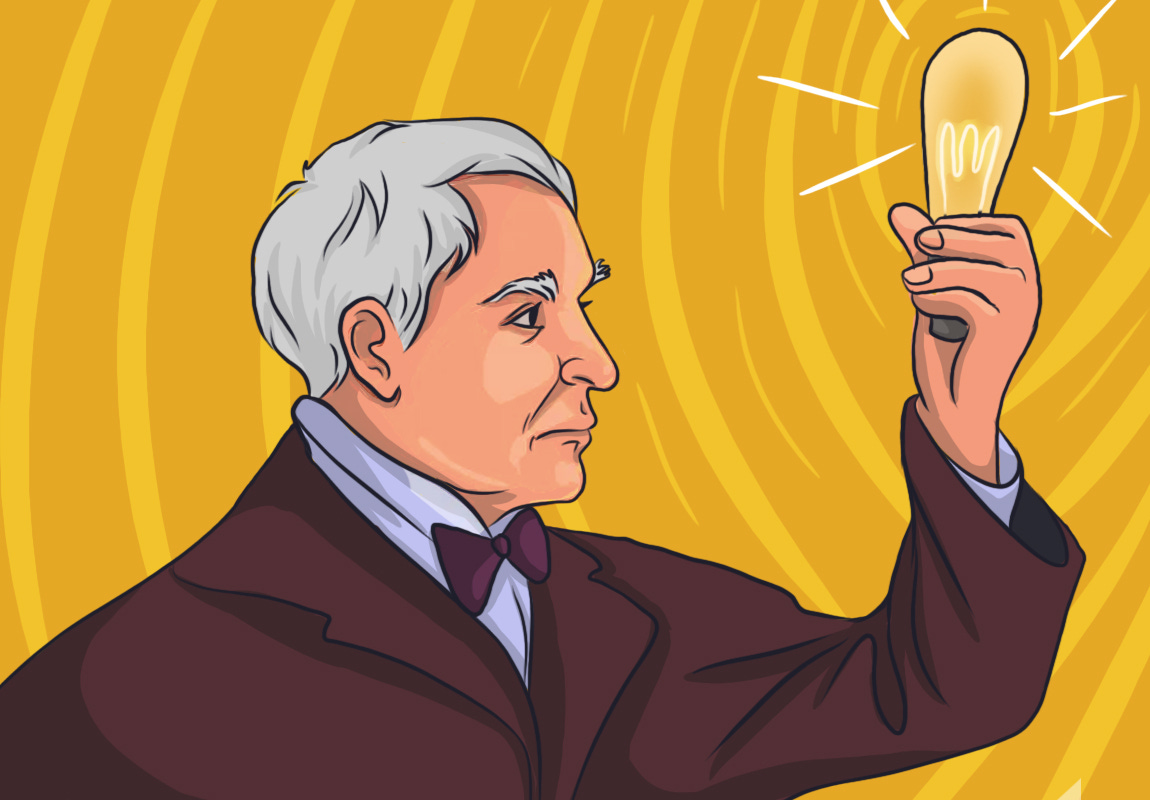Thomas Alva Edison is one of the most famous and prolific inventors of all time. Edison, who invented the electric light bulb, has many other inventions to his credit. In addition to the electric light bulb, Edison used to own over a thousand patents for his inventions, which included the phonograph, alkaline storage battery, electrographic vote recorder, and sound recorder. According to Britannica Encyclopaedia, he was the first in the world to start a research laboratory on an industrial scale. It may be difficult to believe that a boy who was labelled as “stupid” and “hard of hearing” and was expelled from school turned out to be a world-renowned inventor.
Edison was born in Milan, Ohio in the United States, on February 11, 1847. His was an ordinary family who emigrated from Canada to America. His father, Samuel Edison, was in the lumber trade in Milan.
Thomas Edison was the seventh child of Nancy and Samuel Edison. His family had to move to Port Huron in the United States when Edison was eight years old. That was when he started going to school.
Edison was brought up under the tutorship of his mother who did not even have primary education.
One day, the school authorities gave a letter to Edison that was addressed to his mother. Edison sought to know why his mother’s eyes were filled with tears after reading the letter. His mother read out to Edison thus: “Your son is a genius. This school is too small for him and doesn’t have enough good teachers for training him. Please teach him yourself.” From that day, his mother was Edison’s teacher. Edison’s formal education lasted only three months at school.
Edison was brought up under the tutorship of his mother who did not even have primary education. His mother trained him to understand his talents and weaknesses. She was the one who encouraged his skills and laid the foundation for him to become a great inventor.
Flood of inventions
Many inventions that led to the modernization of the world are attributed to Edison. His journey toward his dreams started in 1859 when he was 12 years old while he was working as a newspaper boy, on the trains plying between Port Huron and Detroit. It was during that time he suffered from hearing loss in his right ear, following some illness.
When the industrialisation of the telegraph started in 1863, Edison was interested in studying more about it and he became an apprentice telegrapher. This was a turning point in his life. It was a time when Edison continued with his experiments and realised that he could do many a thing. Later, moving to New York, Edison, along with his friend Franklin Leonard Pope, was able to conduct more experiments.
Edison understood that he had the potential to be an industrialist while doing many other chores. He got his first patent in 1869. He invented the electrographic vote recorder, which could record voting effortlessly. In the same year, he invented the duplex telegraph, which could send two messages at the same time.
It was in 1879 that Edison invented the light bulb which used electricity to produce light.
Working as a telegraph operator helped Edison immensely in his research in the field of communications. Western Union Company was the best of the telegraph companies in those days. Edison was able to outsmart them with the invention of the quadruplex telegraph which was able to send four messages at the same time through a single wire. Later on, Western Union Company itself bought the rights to the quadruplex telegraph from Edison for a hundred thousand dollars. This happened to be the first large reward for Edison and also the maximum a person had received for an invention till that time.
Later, Edison invented the automatic telegraph which could record messages sent through electrical transmission, but it did not succeed in the industry. In continuum with this, Edison invented the electric pen, mimeograph, and phonograph.
It was in 1879 that Edison invented the light bulb which used electricity to produce light. In 1882, he started the distribution of electricity in Pearl Street, New York.
Edison also invented the kinetograph, the movie camera with the ability to take motion pictures, thus paving the way for the creation of movies and videos which we enjoy now.The origins of many gadgets we use today can be traced to Edison in some way. His inventions revolutionised a period of history.
‘The Wizard of Menlo Park’
An important period of Edison’s life started with him establishing a laboratory in Menlo Park, New Jersey. This laboratory, started in 1876, was the first such facility built on an industrial basis in the world. Edison eventually came to be known as ‘The Wizard of Menlo Park’.
Edison had 1,093 patents from America, besides many from Germany, France, and the United Kingdom. He had 389 patents in the fields of light and electricity alone. He progressed to the forefront ignoring obstacles and overcoming difficulties on account of his intelligence, self-confidence and hard work.
However, Edison’s differences with one of his contemporaries Nikola Tesla, led to the controversial ‘War of the Currents’, which was a series of events surrounding the introduction of competing electric-power transmission systems in the late 1880s and early 1890s.
Family
Edison had to face some crises in his personal life. At the age of 24, Edison married 16-year-old Mary Stilwell in1871, and they had three children. Mary supported Edison in all his work, but she did not live long. Mary fell ill and died in 1884, leaving their three children in the care of Edison. This devastated him. Two years later, he married 24-year-old Mina Miller.
Mina Miller was the daughter of the scientist Lewis Miller. Edison and Mina had three more children. Their second son Charles Edison later became the Governor of New Jersey. Charles Edison looked after the Edison industries after the death of Thomas Edison. Theodore Miller Edison, the younger brother of Charles Edison, also became famous and had about 80 patents to his credit.
Thomas Alva Edison died on October 18, 1931, at the age of 84.
Now put on your thinking hats and think about the following questions for a couple of minutes.
Can you think of how Edison’s Kinetograph influenced the invention of movie camera?
How would you describe the contributions of Thomas Alva Edison in the field of Science?
Write down your thoughts and discuss them with your students, children and your colleagues. Listen to their views and compare them with your own. As you listen to others, note how similar or different your views are to others’.
Thank you for listening. Subscribe to The Scando Review on thescandoreview.com.
Happy Teaching!













Thomas Alva Edison: The “stupid” boy who invented the bulb